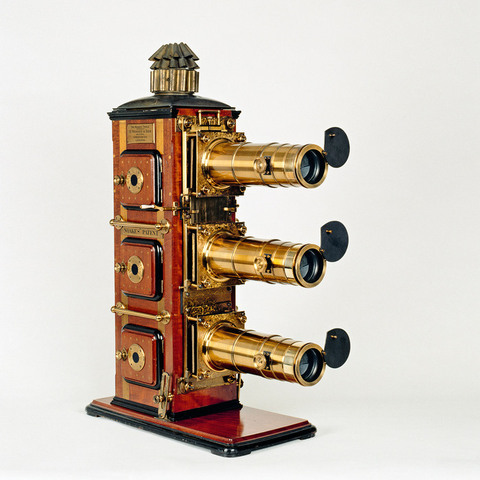Triple lanterne de projection
Fiche détaillée
Type de l'appareil
triple lanterne en acajou, intérieur blindé et amianté, avec six portes (dont trois ne s'ouvrant pas), quatre poignées ; trois objectifs de projection en cuivre verni à crémaillère et avec loquets ; cran de réglage en hauteur du corps de la lanterne ; rideau vertical à manivelle ; cheminée ; boîte de transport en bois (2) ; boîte contenant des accessoires (3)
Auteurs
Noakes & Son David William
Londres, Greenwich, 2 Nelson Street
Fabricants
David William Noakes & Son
Londres, Greenwich, 2 Nelson Street
Utilisateurs
Noakes & Son David William
Londres, Greenwich, 2 Nelson Street
Distributeurs
David William Noakes & Son
Londres, Greenwich, 2 Nelson Street
Sujet du modèle
Informations non disponibles
Objectif
8 cm diamètre
Taille de l'objet
Ouvert :
Informations non disponibles
Fermé :
Longueur : 70 cm
Largeur : 34 cm
Hauteur : 100 cm
Diamètre :
Informations non disponibles
Taille de la boîte de transport
Longueur : 77 cm
Largeur : 35 cm
Hauteur : 94 cm
Remarques
Plaques : " "The Noakes' Triple" D. Noakes & Son, Makers, Greewich, London" & "Noakes' Patent". Gravé sur chaque tube optique : "D. Noakes & Son, Greenwich".
Il existe un modèle du même type construit par Noakes, mais à quatre objectifs : le "Noakesoscope" ou "Noakescope".
"M. D.W. Noakes. The moving spirit in the firm of Messrs. D. Noakes & Son, of Greenwich, is Mr. D.W. Noakes. He has claimed acquaintance with lanterns for the past thirty years, for at the age of eight he received the present of a toy lantern costing a few shillings ; this did very well for a time, but he then wanted something better, and having got this and used it for a while, wanted something better still. [...] This led to his fitting up a workshop in one of his father's (now D. Noakes & Sons) wholesale forage warehouses, close to the riverside at Greenwich. Here the business of a manufacturing optician grew so much an extent that space could not be spared for a showroom and a workshop, so seven years ago this department of Noakes & Sons business was removed to larger premises in Nelson Street, where, under the able management of the son, it grew space, and even included certain engineering work, there being lathes capable of turning metal up to 30 inches in diameter. M. D.W. Noakes is a busy man, for not only does he attend to a section of the forage business as well as the lantern department, but also devotes a portion of this time to dioramic lecturing, and some time ago undertook some extensive work in connection with hydraulic engineering, including the closing of a fracture six feet long in a costly hydraulic cylinder [...]. In connection with the lantern and optical department, our readers are well aware how extensive this has grown, and how popular have become Noakes' patent triple dissolver, compound chamber jet, intermediate jet regulators and other appliances. It is with regret we learn (as far as lanternists are concerned), that at no distant date Mr. D.W. Noakes will be retiring from the optical department of the business engaged in by this firm, for owing to the retiring of Mr. D. Noakes, the senior partner, from active supervision in the forage business, much extra work devolves on the son, and although ably assisted by two brothers (junior partners), the firm has lately entered into some large contracts which will demand most of his time for some years, and with this end in view he has lately purchased a house in Westcombe, where, however, he intends to erect a miniature workshop with lathe and other necessary tools, so that when any idea pertaining to lanterns occurs to him he will be able to practically carry it out in a manner worthy of a lantern enthusiast" (The Optical Magic Lantern Journal and Photographic Enlarger, january 1897, p. 3-4).
"D. Noakes was primary a dealer in animal feeding stuffs and had never taken a very active part in the optical side of the business which was largely run by his son D. W. Noakes. The son had shown an early interest in optical projection and had fitted up a workshop in one of his father's wholesale forage warehouses, close to the riverside at Greenwich. Here the business of a manufacturing optician grew to such an extent that space could not be found for a showroom and a workshop, so in about 1889, this departement of Noakes & Son's business was removed to larger premises in Nelson Street. Under D. W. Noakes' able management the business prospered and in addition to making all kinds of lantern equipement, it undertook certain small scale engineering work. Noakes Jr besides running the optical works, also attended to a section of his father's forage business and even found time to give lantern lectures with one of his magnificent triple lanterns, which he termed the Noakescope" (John Barnes, The Rise of the Cinema in Great Britain, Londres, 1983, p. 64).
Bibliographie
Price list of lantern apparatus, D. Noakes & Son, inventors, patentees, and makers to the trade of improved magic lanterns, dissolving view and lime light apparatus, slides, &c., Greenwich, London, D. Noakes & Son, s.d. [c. 1890], 238 p.
Optical Magic Lantern Journal and Photographic Enlarger, janvier 1892 ; août 1892.
Andrew Pringle, The Optical Lantern for Instruction and Amusement, third edition, London, Hampton & Co., 1899, p. XII.
John Barnes, The Rise of the Cinema in Great Britain, Londres, Bishopsgate Press Ltd, 1983, p. 64.
The New Magic Lantern Journal, vol. 8, n° 3, December 1998, p. 1.
